Posted by Anita on 05.14.09 6:26 AM
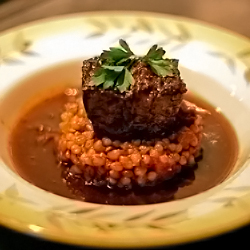 Despite our enduring love for our nieces and pint-sized friends, this blog will never feature the sort of recipes that usually pass for kid-friendly meals. With high-octane cocktails, labor-intensive recipes, and frequent bouts of profanity, no sane reader would ever mistake me for a mommy blogger. And yet, one of the best food books I’ve read in quite some time — one I actually forked over cash to buy — is Hungry Monkey: A Food-Loving Father’s Quest to Raise an Adventurous Eater. A title that’s shelved not with the cookbooks, but in the heretofore unexplored Baby & Toddler section of my local bookstore.
Despite our enduring love for our nieces and pint-sized friends, this blog will never feature the sort of recipes that usually pass for kid-friendly meals. With high-octane cocktails, labor-intensive recipes, and frequent bouts of profanity, no sane reader would ever mistake me for a mommy blogger. And yet, one of the best food books I’ve read in quite some time — one I actually forked over cash to buy — is Hungry Monkey: A Food-Loving Father’s Quest to Raise an Adventurous Eater. A title that’s shelved not with the cookbooks, but in the heretofore unexplored Baby & Toddler section of my local bookstore.
I doubt Hungry Monkey would have found its way to our house if we weren’t already friends with the book’s author, Matthew Amster-Burton, and his daughter Iris. But that surely would have been my loss, because once I picked it up, I couldn’t stop reading. Or laughing. Matthew’s a pretty funny guy, something you may already know if you read his blog, Roots & Grubs, or his witty writings on Culinate, Gourmet.com, or pretty much anywhere else you go for clever, thoughtful food writing these days. And even if you couldn’t give a fig for the intricacies of raising a little fresser, you can’t help but be drawn in by Matthew’s no-nonsense ideas about food.
Now, in the interest of full disclosure, I think it’s only fair to admit that I’m friends not only with Matthew, his wife Laurie, and little Iris, but also with grandma Judy, and many of the other characters in the book — Tea, Shauna, Molly, and the gang — so reading a chapter is like old home week for me. Some of my favorite memories from our Seattle days involve the dinner parties we used to throw. Every New Year’s Day, we’d make an enormous pot of cassoulet and invite our friends to polish it off; the Amster-Burtons were among the 50 or so food-obsessed friends who came to the second-annual fête.
I don’t remember much else from that day, but I do remember Iris — who had just turned one — sitting on our kitchen floor and calmly polishing off an adult-sized plate of braised pork, beans, and duck confit. Reading the book, I was tickled that Matthew remembered, too: The cassoulet-gobbling tale is but one of dozens of spot-on anecdotes he uses to illustrate his theories. (In this case, the point is: “Stew is the ultimate in baby food. It’s easy to make. It’s easy to eat: you don’t even need teeth.”)
But aside from personal affection, Matthew’s stories of cooking for Iris are universal, whether you’re a parent, a proud aunt, or even kid-agnostic. In a way, my feelings about Hungry Monkey are similar to Matthew’s own enthusiasm for his daughter’s culinary education:
“I was gung-ho about sharing our food with Iris for the same reason people share food with each other everywhere: it’s fun. It was the first opportunity for Iris and me to share an experience and enjoy it for the same reasons. I mean, I liked playing peek-a-boo (I called it “peekytoeâ€) because it made Iris laugh, but it’s not like it’s something Laurie and I played before Iris was born — or, at least, I wouldn’t admit to it. But I like enchiladas. Iris likes enchiladas. We can agree on enchiladas.”
On the surface, I may not have a lot in common with a stay-at-home dad. But our mutual love of food — and a fondness for belly laughs — makes Hungry Monkey worth a read, even if you have no experience with the tribulations of breastfeeding, or coaxing a toddler to the dinner table. With the exception of a couple of purees, there’s hardly a recipe in the book that looks or tastes like kid chow. Last winter, Cameron and I tested a dozen or so of the recipes during the book’s development, and we’ll personally vouch for Matthew’s stacked enchiladas, Cornish pasties, and bibimbap, not to mention a recipe for carnitas that’s so quick and simple we didn’t believe it would work. (It did, deliciously.)
If you need further convincing, plan to pop by one of Matthew’s readings in the Bay Area the week of May 24 (check the schedule here). Photographic evidence indicates that Hungry Monkey is even more hilarious when read aloud by its author.
If you can’t get to one of Matthew’s book-signings, there’s still a chance to have your own brush with fame: I’ve got an extra copy of the book — there is some payoff for being a recipe-tester! — and it just so happens that Matthew will be visiting us on his swing through town. So, if you’d like to win an autographed copy of Hungry Monkey, leave a comment below telling us about your favorite food when you were little. Next weekend, I’ll pick a comment at random and get in touch with the lucky winner to ask how they’d like the book inscribed.
In the meantime, here’s a little proof that not all kid-friendly food has to look like stewed prunes and taste like mush.
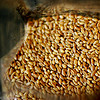
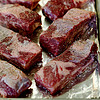

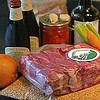
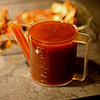
Beer-Braised Short Ribs with Wheat Berries
– from Hungry Monkey by Matthew Amster-Burton, reprinted with permission
3 to 4 pounds beef short ribs (flanken or English-style)
salt and pepper
3 tablespoons olive oil
2 cloves garlic, thinly sliced
1 large onion, diced
1 carrot, peeled and diced
1 celery stalk, diced
1 cup wheat berries (see note)
2 bottles (2-1/4 cups) porter-style beer
1 cup canned crushed tomatoes, not drained
1-1/2 cups chicken stock
2 tablespoons minced parsley
Preheat oven to 450°F.
Season the ribs liberally with salt and pepper and place them on a foil-lined baking sheet (bone-side down if you’re using English style ribs). Roast 45 minutes or until they’re nicely browned and have rendered plenty of fat. Reduce oven temperature to 275°F.
While the ribs are roasting, heat the olive oil in a Dutch oven or other large pot over medium heat. Add the garlic, onion, carrot, and celery. Cook until vegetables are limp but not browned, 5 to 10 minutes.
Add the wheat berries, beer, tomatoes, and chicken stock, and stir to mix. Add the browned ribs, raise the heat to medium-high, and cover. When the pot is boiling, transfer it to the oven (you did remember to turn it down to 275°F, right?). Braise for 2-1/2 to 3 hours, or until meat is very tender. Season with additional salt and pepper to taste.
If serving immediately, remove the meat and strain the sauce, then skim off the fat with a spoon or gravy separator. Otherwise, cool to room temperature and refrigerate everything together, skimming off the solidified fat before reheating. Give each person one or two ribs (remove the bones before serving if you like), a ladleful of wheat berries and sauce, and a sprinkling of parsley.
Note: Wheat berries are available in the bulk section at any health food store. Mine has sometimes managed to run out, so I’ve substituted pearl barley to good effect. Hard or soft wheat berries will work. For another variation, substitute French green lentils for the wheat berries.
cookbooks, meat, other blogs, recipes
26 Comments »




Posted by Anita on 01.12.09 7:22 PM
 After two-plus weeks in London, we knew it was going to be difficult to get back to the grind, and the cold, grey weather here in San Francisco wasn’t doing anything to help us get over our jetlag.
After two-plus weeks in London, we knew it was going to be difficult to get back to the grind, and the cold, grey weather here in San Francisco wasn’t doing anything to help us get over our jetlag.
In a rare fit of travel wisdom, I’d planned our return for Saturday, to give us time to do little things like food shopping and laundry before heading back to work. But we arrived home far too late to get to our usual market at the Ferry Plaza, and the idea of trudging through a brightly lit supermarket didn’t seem the slightest bit appealing.
So after a fortifying Sunday morning breakfast, we headed across the Golden Gate bridge, in search of the Marin Civic Center farmers market. Even though this market isn’t much further from home than the downtown Berkeley market, we’d never checked it out. What we found was pretty impressive: A good number of stalls — maybe close to 100 — with a lot of variety, even in the middle of winter.
 We certainly had no problem finding meat. Marin Sun Farms was there, as were the Prather Ranch boys and Devil’s Gulch Ranch — a name we’ve seen on menus, but never bought; they don’t sell at the SF markets. By the time we arrived, all they had left was a big five-pound pork shoulder roast. We hemmed and hawed, then decided that we could make a big batch of carnitas and save the leftovers for a later meal. A vendor from San Luis Obispo — technically outside our challenge radius, but we fudged it — was selling avocados, and a bakery from Sacramento had corn tortillas; we’d made the right decision.
We certainly had no problem finding meat. Marin Sun Farms was there, as were the Prather Ranch boys and Devil’s Gulch Ranch — a name we’ve seen on menus, but never bought; they don’t sell at the SF markets. By the time we arrived, all they had left was a big five-pound pork shoulder roast. We hemmed and hawed, then decided that we could make a big batch of carnitas and save the leftovers for a later meal. A vendor from San Luis Obispo — technically outside our challenge radius, but we fudged it — was selling avocados, and a bakery from Sacramento had corn tortillas; we’d made the right decision.
We also picked up a pretty bone-in pork chop from Marin Sun, plus the usual assortment of vegetables and starches. Once we returned home, I popped the pork chop in my usual cider brine for a few hours. For our first Challenge meal of the week, we served it with mashed potatoes and a really nice chopped salad of romaine, avocado, radishes, carrots, and cucumbers, all tossed in a citrusy dressing and topped with grated dry Jack. (I was mimicking a salad I used to love ordering at Two before they went downhill, and I think I got pretty darned close.)
Every time I opened the fridge, that enormous pork shoulder was staring back at me. With a full week of evening commitments ahead, I quickly figured out that I’d bitten off more than I could chew; there just wasn’t time in our schedule for the full evening of patient simmering that carnitas requires. And with a slate of office projects piling up, there was no way I could work from home to coddle it.
I wondered aloud if the Crock-Pot might offer a solution, and Cameron agreed that it might be worth a try. “The worst thing that happens is you end up with pork stew.” A quick cruise around the Web didn’t really turn up much in the way of a trustworthy recipe, so I decided to wing it. I used our usual carnitas recipe, with a couple of changes: I left the meat in larger chunks to combat the tendency for everything to turn to mush. I also reduced the liquid — slow cookers retain a lot more moisture than even the best-sealed pots — and kicked up the brightness with a little citrus, to compensate for slow cooking’s flavor-dulling effect.
I’d popped the ingredients in the pot, then headed to the office, fully expecting to return home in about 8 hours to keep an eye on the tail end of the cooking process. Naturally, work dramas conspired against me, so it was nearly 12 hours later that I walked in the front door. A heavenly smell from the kitchen relieved some of my fears that I’d created a pile of overcooked, dry slop.
I shouldn’t have fretted. The part of the meat that wasn’t submerged got pretty toasty… an unexpected bonus. The rest of the meat was perfectly cooked, juicy and tender, with just enough connective tissue left to keep things together until you hit it with a fork.
In a traditional carnitas recipe, the braising liquid gets simmered down — with the meat in it — at the end of the cooking process; the meat gets nice and crispy in the fat that remains after the broth simmers away. To simulate this effect, we drained the juices and skimmed off the fat to sear the meat. And as a bonus, we have an ice-cube tray full of really yummy pork broth.

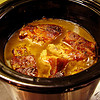
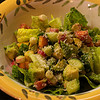
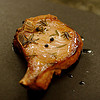

Crock-Pot Carnitas
4 pound boneless pork shoulder
1T whole cumin seed, lightly chopped or crushed
2 bay leaves
1 onion, quartered
1 cup rich pork or chicken stock
1 oz orange juice or Meyer lemon juice
salt, to taste
water, as needed
Cut the pork shoulder into large chunks, and sprinkle with the salt and cumin. Place in the Crock-Pot with the bay, onions, stock, and juice. Add enough water, if needed, to come halfway up the meat. Cover with lid, set pot on low, and cook for 10-12 hours, until meat is very tender.
Remove the meat from the pot and set aside in a warm place. Pour the cooking liquid into a fat separator, let settle, and then pour the defatted broth into a wide pan or baking dish to cool, reserving for another use. (Alternately, use a glass measuring cup and a turkey baster to separate the fat from the broth, or your usual fat-separating method.)
Heat a large skillet, and add enough of the skimmed carnitas fat to the pan to cover the surface well. Pull the meat apart, creating pieces approximately 1 inch long, and add to the pan once the fat is sizzling. Brown the meat until crispy on the outside, turning with tongs as needed. Remove each piece from the pan as it browns on all sides, keeping warm until ready to serve.
Serve with warm tortillas and your choice of condiments: salsa, chopped cilantro and onions, guacamole, sliced radishes, etc.
Dark Days challenge, farmers markets, locavore, meat, recipes
6 Comments »




Posted by Anita on 05.04.08 11:30 PM
 Â A few years ago on May 5, I found myself in Puebla — the city where the historic Cinco de Mayo victory of Mexican forces over their French invaders took place. When I asked my taxi driver if there were any festivities planned to commemorate the anniversary, he looked at me like I was crazy: “It’s a military holiday, mija.”
 A few years ago on May 5, I found myself in Puebla — the city where the historic Cinco de Mayo victory of Mexican forces over their French invaders took place. When I asked my taxi driver if there were any festivities planned to commemorate the anniversary, he looked at me like I was crazy: “It’s a military holiday, mija.”
Even in Puebla, the idea of Cinco de Mayo as an event worthy of feasting and celebration seemed utterly unknown. Every Poblano who I told of the norteamericano version of the holiday — at best a celebration of Mexican-American pride, at worst an excuse to drink excessive quantities of nasty sour-mix Margaritas — expressed complete astonishment, shaking their heads as though they’d just discovered yet another reason to pity our confused country.
But no matter: I hadn’t gone to Puebla in search of patriotic parades or folklorico dancing in the city squares. I’d gone there to spend a few days relaxing before meeting friends in the bustle of Mexico City, to explore the city’s beautiful colonial architecture, and to eat Puebla’s famously delicious food.
Strolling the streets the morning of my arrival, I found a peasant woman standing in a tiny off-the-path plaza, selling tamales out of a steaming metal can. There were three choices, but I barely registered the first two: The last, the one I chose, was mole. There are many moles in Mexico of course, but the best-known — the chocolate-tinged, brick-red one most Americans think of when they think of mole — hails from Puebla. Reputedly invented by an order of nuns in honor of their bishop’s visit, mole poblano is sinfully delicious and worth every bit of the hassle it takes to make it. It also makes an excellent tamale filling, a perfect breakfast after 12 hours of travel by plane and bus and taxi.
Thus fortified, I wandered Puebla’s tidy grid of streets without much of a plan. I explored the cathedral of the angels, considered one of the country’s most stunning churches, followed by a plate of tacos árabes at a tile-bright shop called Tacos Tony. I watched the propane vendors ply their wares: Pulling their truck up to the middle of a residential block, they blared their promotional jingle — a festive snippet of dance music, punctuated by a deep bass voice crying “EL GAZ!!” — and the ladies of the house would come to the street bearing tanks to be filled. On my way to the Mercado Carranza, I stumbled across a Victorian-era shopping arcade featuring an enormous stained-glass gazebo and cobblestone footpaths. And once I reached the mercado, I discovered my favorite Puebla snack: Cemitas, at a stand called El As de Oros.
Some folks will tell you that a cemita is little more than a torta served on a Puebla-style roll rather than a more typical bolillo, but the differences run a little deeper. Like tortas, cemitas are available with the diner’s choice of meat fillings — stew-like tinga, crispy carnitas, chewy cueritos, or golden-brown milanesa. And like tortas, cemitas are essentially a taco on a bun.
Unlike a torta, though, you rarely see mayonnaise on a cemita, nor frijoles; lettuce is a definite no-no. Aside from the meat, toppings nearly always include a generous amount of avocado, a bouncy cheese like panela or queso de Oaxaca, a slather of salsa roja, and a pungent herb called papalo. Like tacos árabes, cemitas have their roots in the cuisine of Puebla’s Lebanese immigrants. The word itself means “semite”, a nod to the soft, eggy, sesame-seeded rolls borrowed from the Arabic kitchen.
Alas, unlike in Los Angeles — where a gaggle of cemita trucks are giving their taco-vending cousins a serious run for the money — you’d be hard pressed to find a cemita for sale in San Francisco. But of all the comidas tÃpicas poblanas, cemitas are the easiest to make. Even if you quake at the thought of a day-long adventure required to make authentic mole poblano, or the near-impossible task of replicating spit-grilled tacos árabes at home, cemitas are a cinch.
The ones we’re enjoying as our Cinco de Mayo treat are filled with the homemade chicken-fried-steak called milanesa, arguably the most-popular cemita filling. But if you’ve got some carnitas or tinga left over from your own festivities, I guarantee they’ll find a happy home between two halves of a sesame-seed bun.

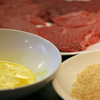


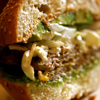
Cemitas Poblanas de Milanesa
1 pound beef sirloin tips, pounded thin
1/2 cup flour, seasoned with 2tsp salt and 1tsp pepper
1 egg, well scrambled with 1T water
1/2 cup fine breadcrumbs
oil for frying
—–
4 challah rolls, preferrably sesame seeded
1 mild white or red onion, sliced thickly
8 oz panela or queso de Oaxaca, or other fresh and creamy Mexican cheese
your favorite mexican salsa roja (the cooked smooth sort, not like pico de gallo)
– or substitute a few pureed chiles chipotles en adobo thinned with water or vinegar
2 large avocados, peeled and sliced
16 sprigs of papalo (or substitute cilantro)
Pound the meat flat with a meat tenderizer, 1/4-inch or thinner, and pat dry with a paper towel. If the pieces are larger than sandwich size, you may want to cut them apart. Dredge the meat in the seasoned flour, brushing off any excess until just the thinnest layer remains. Dip quickly in the egg, again taking care to leave as little as possible on the meat, and then a light layer of breadcrumbs.
In a deep skillet, add sufficient oil to shallow-fry at a depth of 1/4 inch. (In my 10-inch skillet, I used about 3/4 cup.) Heat the pan over medium heat until oil is shimmering but not smoking. Place the breaded meat in the pan and fry until golden brown on both sides, just a few minutes total. Remove from the pan and keep warm on a cooling rack in a warm oven.
Cut the buns in half, and lightly toast under a broiler or on a griddle. While buns are toasting, coarsely smash 1/3 of the avocado in a bowl with the back of a fork. Spread the mashed avocado on the bottom of each bun, and season with salt. Pour the salsa onto a small saucer, and dip the top half of each bun into the salsa to coat; set aside. Top the bottom half of the bun with a piece of the milanesa, followed by cheese, onions, papalo or cilantro, and the remaining sliced avocados, and the salsa-smeared top.
Something to drink?
– Margaritas: Drink of the Week 9/15/06
– Michelada: Drink of the Week 11/24/06
– Sangrita: Drink of the Week 6/1/07
holidays & occasions, meat, Mexican, travel
3 Comments »




Posted by Anita on 04.07.08 4:22 PM
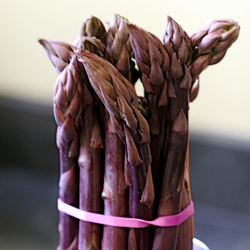 I think it’s safe to say that by any objective measure, Dark Days are well behind us here in San Francisco. Asparagus has been on the farm tables for a month, strawberries made their Ferry Plaza debut this Saturday, and — hooray! — the first pasture-raised chicken of 2008 made its way into our bag (and our bellies) yesterday.
I think it’s safe to say that by any objective measure, Dark Days are well behind us here in San Francisco. Asparagus has been on the farm tables for a month, strawberries made their Ferry Plaza debut this Saturday, and — hooray! — the first pasture-raised chicken of 2008 made its way into our bag (and our bellies) yesterday.
Spring has indeed sprung. And with the dawning of a new season comes the end of the Dark Days Eat Local Challenge.
I know you probably won’t be shocked to hear that April 1 didn’t look a whole lot different in our kitchen than March 31. We’re not going to stop hunting down locally produced foods just because we aren’t documenting every last morsel, after all. Three of the last five dinners we’ve eaten have been made with 100% local ingredients, so I think we’re safely launched down this particular path.
 And for that, I owe huge debt to Laura — for dreaming up Dark Days, for hosting the weekly roundups last fall, and for extending the challenge into 2008 when we all clamored for more. I can only imagine how she manages her own blog and handles her roundups of every Dark Days blogger in the country, all while moving onto her new farm, raising a new brood of chicks, and working a full-time job. (Honestly, I’m exhausted just thinking about it…) I know in my heart that we’d never have dug as deep into our food chain if it hadn’t been for the thrill of the challenge, and knowing we had a built-in audience of Dark Days participants who would share our excitement.
And for that, I owe huge debt to Laura — for dreaming up Dark Days, for hosting the weekly roundups last fall, and for extending the challenge into 2008 when we all clamored for more. I can only imagine how she manages her own blog and handles her roundups of every Dark Days blogger in the country, all while moving onto her new farm, raising a new brood of chicks, and working a full-time job. (Honestly, I’m exhausted just thinking about it…) I know in my heart that we’d never have dug as deep into our food chain if it hadn’t been for the thrill of the challenge, and knowing we had a built-in audience of Dark Days participants who would share our excitement.
Although we’ll stop with our periodic Dark Days wrap-ups, you haven’t heard the last of our locavore ways. In fact, I had high hopes of debuting a new “Bay Area Pantry” page this weekend, showcasing all the products we’ve found that are grown or produced within our foodshed radius. The good news is that it’s 90% ready; the bad news is that time ran out on me, and the final Dark Days roundup must go on, with or without me. I still need to add some links, photos, and section headings, but I’ll let you know when the pantry is fit for public consumption.
In the meantime: Here’s to spring — Let the asparagus-gorging begin!

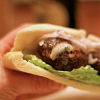


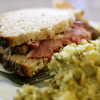
Dark Days Ticker — March 16-31
– Dark Days dinners at home: 9 out of 16
– Locavore dining-out: MÅno, O Izakaya, Marin Sun Farms butcher shop / tour lunch
– New recipes: Reuben sandwiches, feta-stuffed lamb burgers, English muffin bread
– Old faves: Not-Spam and Eggs, choucroute garnie, gumbo, beef stew, Thai beef salad
– Freezer fodder: A16 meatballs, beef stew, Mamster’s carnitas, pasta bolognese
New local items in the pantry:
Middle Eastern Baking lavash (Millbrae)
Hamati pita (San Bruno)
Sconehenge English muffins (Berkeley)
Achadinha brined goat feta (Petaluma)
Fatted Calf sauerkraut, andouille, bockwurst, pastrami (Napa)
Marin Sun Farms slab bacon (Point Reyes)
Alexander Valley Gourmet sauerkraut
cooking, Dark Days challenge, locavore, other blogs
6 Comments »




Posted by Anita on 03.16.08 10:01 AM
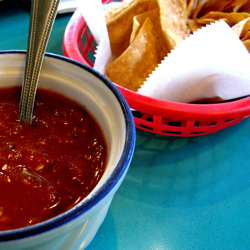 My Dark Days Challenge cohorts, please avert your eyes: With the exception of two or three breakfasts, there was absolutely nothing sustainable, local, or even organic about the way we spent our long Presidents Day weekend. Que lastima — we traded local for loco, spending a crazy four days eating nothing but Mexican food.
My Dark Days Challenge cohorts, please avert your eyes: With the exception of two or three breakfasts, there was absolutely nothing sustainable, local, or even organic about the way we spent our long Presidents Day weekend. Que lastima — we traded local for loco, spending a crazy four days eating nothing but Mexican food.
Since time was limited on Friday morning before work, we headed to an old standby. Los Jarritos has been the scene of more Sunday breakfasts than we can count, and one or two dinners over the years. The coffee is terrible, so stick with the Mexican chocolate, and the chilaquiles are limp and over-egged. But it’s hard to complain too much about a place that serves homemade tortillas, and the service is always so adorably welcoming that we’re more than a little forgiving of Jarritos’ shortcomings.
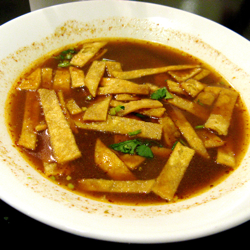 Maybe it’s was a case of diminished expectations, but I have to say that my lunch at Frontera Fresco on the lower level of Macy’s Union Square was not nearly the dreck-fest I was expecting after reading some early critiques. Yes, it’s corporate chain food — think Wolfgang Puck Express goes to Mexico — but it’s certainly no travesty.
Maybe it’s was a case of diminished expectations, but I have to say that my lunch at Frontera Fresco on the lower level of Macy’s Union Square was not nearly the dreck-fest I was expecting after reading some early critiques. Yes, it’s corporate chain food — think Wolfgang Puck Express goes to Mexico — but it’s certainly no travesty.
It might be too strong to say that I enjoyed my meal, but I was served a thoroughly decent, well-garnished bowl of tortilla soup, and an unorthodox (but not unpleasant) chicken torta. I laughed out loud at the sandwich’s sundried tomato garnish, and its lettuce seemed to be dressed in Good Seasons Zesty Italian. But everything else was in the ballpark: rich frijoles, tinga-style chicken, and a chunky slab of queso añejo. Don’t get me wrong: It’s not fabulous, and it’s definitely not worth a special trip, but there are certainly worse ways to spend your $10 downtown. And I’d be downright ecstatic to find a Frontera Fresco branch in an airport.
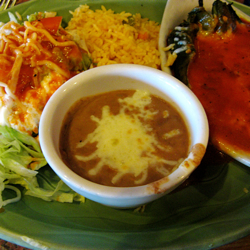 Friday afternoon, I hopped a southbound CalTrain after work. Cameron picked me up at Mountain View station and in just a few moments we were pulling into the parking lot of our favorite Mexican restaurant, Fiesta del Mar. Our friends Jason and Margaret introduced us to this fabulous place way back in the day — more than a decade ago, now — and we’ve been coming here religiously ever since. Sure it’s crazy to drive an hour to go to dinner, but such is our devotion.
Friday afternoon, I hopped a southbound CalTrain after work. Cameron picked me up at Mountain View station and in just a few moments we were pulling into the parking lot of our favorite Mexican restaurant, Fiesta del Mar. Our friends Jason and Margaret introduced us to this fabulous place way back in the day — more than a decade ago, now — and we’ve been coming here religiously ever since. Sure it’s crazy to drive an hour to go to dinner, but such is our devotion.
And we’re not the only fans: Plaques on the wall attest to the restaurant’s enduring popularity: They’ve been voted “Best Mexican Restaurant” by the local paper every year but one since the early 1990s. They’re justly famous for their shrimp dishes — Cameron loves their Camarones Alex and the Camarones a la Diabla — but I love them for their great margaritas (El Jimador, rocks, salt… thanks!) and their unbattered chiles rellenos. There’s almost always a line out the door, but the tables turn quickly and you won’t regret the wait.
 Saturday morning found us at our usual spot: The Ferry Plaza farmers market, and specifically the Primavera stand. Although this market favorite offers chilaquiles nearly every Saturday, they mix things up a little by varying the sauce; one week it’s a green tomatillo-serrano blend, the next it’s a tomato-chipotle salsa, and the next it might be a puree of guajillo chiles (as it was that weekend).
Saturday morning found us at our usual spot: The Ferry Plaza farmers market, and specifically the Primavera stand. Although this market favorite offers chilaquiles nearly every Saturday, they mix things up a little by varying the sauce; one week it’s a green tomatillo-serrano blend, the next it’s a tomato-chipotle salsa, and the next it might be a puree of guajillo chiles (as it was that weekend).
A plate of salsa-sauteed chips served with Cameron’s all-time favorite soft-scrambled eggs and some pretty delicious black beans… ahh, brunchly perfection. Of course, we couldn’t resist ordering a plate of tacos al pastor — and its perfect pairing, piña agua fresca. Weighted down by our mega-breakfast, we wandered our way around the market, vainly trying to work off our stuffedness while finishing our weekly shopping.
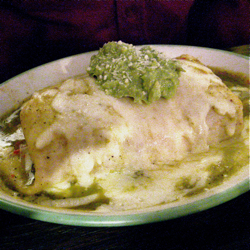 Not surprisingly, we weren’t hungry again until dinnertime. After the sun set, we made our way to the Daly City border to check out a little hole-in-the-wall we’d heard good things about. Lisa’s Mexican Restaurant looks like a biker bar from the outside, with its microscopic windows, spotlit sign, and ugly burglary bars facing Mission Street.
Not surprisingly, we weren’t hungry again until dinnertime. After the sun set, we made our way to the Daly City border to check out a little hole-in-the-wall we’d heard good things about. Lisa’s Mexican Restaurant looks like a biker bar from the outside, with its microscopic windows, spotlit sign, and ugly burglary bars facing Mission Street.
But when you step inside, you’re entering another world. Every surface but the floor is covered with goofy stuff — photos of old Mexican movie stars, life-size parrots, oversized sombreros, and creepy paintings of big-eyed children. The overall effect is like dining inside some crazy abuela’s closet, but somehow it feels cozy, not chaotic. The welcome is friendly, both from the staff and the other patrons. And the food…
Well, honestly, I don’t want to get your hopes up. Lisa’s is decidedly not gourmet, and it definitely isn’t in the same league as Fiesta del Mar. But if you’re a homesick Southern Californian pining for the cheesy combo-plates of your youth, Lisa’s will fill your heart and belly in a way that you’ve never experienced north of the Grapevine. Their chile relleno sauce is just right (it’s the kind with chunks of celery like you see absolutely everywhere in L.A.) and their crispy tacos are dynamite. The best thing we’ve had at Lisa’s — and I am embarrassed to admit, we’ve been back almost every week since we discovered it – is their chile verde. Cameron likes to ask for it in their Lisa’s Especial, a football-sized ‘wet’ burrito stuffed with everything a homesick Angeleño needs to feel right again.
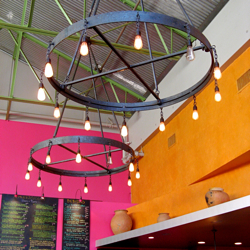 Sunday we crossed the bridge for brunch at our East Bay fave, Tacubaya. The spinoff of Temescal’s oft-lauded Doña Tomás, this taqueria — tucked behind Sur La Table and Café Rouge on Berkeley’s Fourth Street restaurant row — lures breakfasters into gorgeous skylit space decked out in tropical-fruit colors and natural wood surfaces. It’s a neighborly place, albeit one with a very calculated and upscale vibe, and though the crowds come out in force, the line moves fast and there’s never much of a wait for a table.
Sunday we crossed the bridge for brunch at our East Bay fave, Tacubaya. The spinoff of Temescal’s oft-lauded Doña Tomás, this taqueria — tucked behind Sur La Table and Café Rouge on Berkeley’s Fourth Street restaurant row — lures breakfasters into gorgeous skylit space decked out in tropical-fruit colors and natural wood surfaces. It’s a neighborly place, albeit one with a very calculated and upscale vibe, and though the crowds come out in force, the line moves fast and there’s never much of a wait for a table.
No matter what time of day we visit, we can never resist an order of churros y chocolate; other breakfast fare mostly starts and stops with so-so chilaquiles and decent variations on huevos, plus menudo on weekends. Like its O-Town sibling, Tacubaya bases its menu on local produce and sustainable meat.
 Later in the day, we took a long-overdue tour of Oakland’s taco-truck scene. We used to love planning day-long taco crawls with our Seattle crew, and when we first moved back to San Francisco, we tried to get our new friends to follow suit. Various circumstances conspired against us — ranging from a surreal bout of foul weather to half the group catching one of those pandemic colds — and eventually we gave up trying to get everyone across the bay at the same time. But I’d kept my notes, adding a truck here or a cart there from time to time, and waited for the right day. And now that day had come.
Later in the day, we took a long-overdue tour of Oakland’s taco-truck scene. We used to love planning day-long taco crawls with our Seattle crew, and when we first moved back to San Francisco, we tried to get our new friends to follow suit. Various circumstances conspired against us — ranging from a surreal bout of foul weather to half the group catching one of those pandemic colds — and eventually we gave up trying to get everyone across the bay at the same time. But I’d kept my notes, adding a truck here or a cart there from time to time, and waited for the right day. And now that day had come.
We started out at the corner of 22nd and International, at a former A&W Drive-In that’s now home to not one but two taco trucks. Tacos Sinaloa features the usual assortment of meats — carnitas, chorizo, carne asada, and such — ensconsed in the eater’s choice of tacos, burritos, tortas and more. Across the parking lot, Mariscos Sinaloa offers all these plus fish tacos, tostadas de ceviche, and other seafood-based items. I opted for a taco full of deliciously meaty carnitas; Cameron had a muy sabroso shrimp taco from the other truck. Off to a good start, we ate our way up and down the boulevard, stopping at any truck where we saw more than two people in line. Our favorites: El Grullo’s tacos al pastor, Tacos Guadalajara’s shredded carnitas, and the cabeza at El Novillo in the shadow of Fruitvale BART.
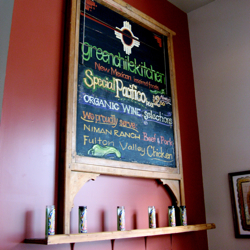 Monday is a hard day to find Mexican breakfast in the City; many family-run businesses take the day off after their weekend rush. We didn’t want to repeat ourselves, so we headed to Green Chile Kitchen over in NoPa. It’s the kind of storefront cafe you find in nearly every San Francisco neighborhood: Wood tables, tall windows, a chalkboard menu, and a tall counter where you place your order.
Monday is a hard day to find Mexican breakfast in the City; many family-run businesses take the day off after their weekend rush. We didn’t want to repeat ourselves, so we headed to Green Chile Kitchen over in NoPa. It’s the kind of storefront cafe you find in nearly every San Francisco neighborhood: Wood tables, tall windows, a chalkboard menu, and a tall counter where you place your order.
Sadly, the food’s no better than average, and it’s definitely Southwestern rather than Mexican. But they use quality ingredients (mostly organic produce, Niman Ranch meats, and Fulton Valley chicken) and there’s good coffee, easy street parking, and a pleasant little vibe.
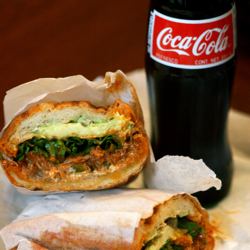 As we were leaving NoPa, the once-cloudy day turned sunny, so we grabbed the dogs and headed back to the Mission. There’s nothing better on a bright winter afternoon than a lazy meander down the eastern stretch of 24th Street, where you can walk and shop for hours without hearing a single word of English. When we’d finally gotten our appetites back, Cameron entertained the pups while I popped into Tortas Los Picudos, a cheerful slice of chaos where they sell grilled Mexican sandwiches and licuados (which many shops translate as “milkshakes” although they’re really more like smoothies).
As we were leaving NoPa, the once-cloudy day turned sunny, so we grabbed the dogs and headed back to the Mission. There’s nothing better on a bright winter afternoon than a lazy meander down the eastern stretch of 24th Street, where you can walk and shop for hours without hearing a single word of English. When we’d finally gotten our appetites back, Cameron entertained the pups while I popped into Tortas Los Picudos, a cheerful slice of chaos where they sell grilled Mexican sandwiches and licuados (which many shops translate as “milkshakes” although they’re really more like smoothies).
Fillings at Los Picudos run the gamut from basic ham-and-American or turkey-and-Swiss to belly busters like the Cubana. A very distant relation to the medianoche you may be used to, Los Picudos’ porcine homage to La Isla includes roast pork, ham, queso fresco, lettuce, jalapeños, mayonnaise, butter… and a foot-long hotdog! We wisely chose to split a spicy pulled-pork torta, and picked up a Mexican Coke at Casa Lucas on our way back up the block.
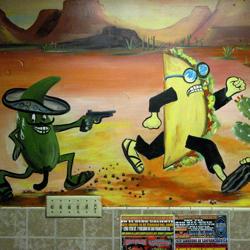 By the time we were hungry again, our options on a Monday night had diminished to a handful of late-night taquerias. Wanting to make sure we ended our weekend of gluttony on a high note, we popped down the hill to our nearby favorite, El Gran Taco Loco. Sandwiched in between a hard-liver bar and our local branch of Cole Hardware, Taco Loco has won our hearts despite its interrogation-room lighting, uncomfortable booths, and goofball murals.
By the time we were hungry again, our options on a Monday night had diminished to a handful of late-night taquerias. Wanting to make sure we ended our weekend of gluttony on a high note, we popped down the hill to our nearby favorite, El Gran Taco Loco. Sandwiched in between a hard-liver bar and our local branch of Cole Hardware, Taco Loco has won our hearts despite its interrogation-room lighting, uncomfortable booths, and goofball murals.
We long ago discovered that the burritos and other semi-Americanized offerings at Taco Loco aren’t much to write home about, but their tacos — and most specifically, their carnitas tacos — are a thing of beauty and a joy forever. (Or at least the next 4 to 6 hours.) Cameron’s a huge fan of their birria, — a goaty, dark-chile-flavored soup that’s good for whatever ails you on a Sunday morning. But for our last meal of the long weekend, we kept it simple: A carnitas super-taco for me, and a buche taco for the bald guy. It certainly wasn’t the best meal of the bunch, but a late-night snack at our neighborhood favorite was definitely a fitting end to a gastronomical journey that spanned three area codes.
Los Jarritos
901 South Van Ness
San Francisco, CA 94110
415 648.8383
Frontera Fresco
170 O’Farrell Street, Macy’s basement level
San Francisco, CA 94103
415 296.4349
Fiesta del Mar
1005 N. Shoreline Blvd
Mountain View CA 94043
650 965.9354
Primavera
Ferry Plaza Farmers Market (Embarcadero at Market)
San Francisco, CA
Lisa’s Mexican Restaurant
6582 Mission Street (near John Daly Blvd)
Daly City, CA 94014
650 756.6289
Tacubaya
1788 4th Street
Berkeley, CA 94710
510 525.5160
Tacos Sinaloa / Mariscos Sinaloa
International Blvd & 22nd Avenue
Oakland, CA 94601
El Grullo
International Blvd & 26th Avenue
Oakland, CA 94601
Tacos Guadalajara
International Blvd & 44th Avenue
Oakland, CA 94601
Tacos El Novillo
1001 Fruitvale Avenue
Oakland, CA 94610
Green Chile Kitchen
601 Baker Street
San Francisco, CA 94117
415 614.9411
Tortas Los Picudos
2969 24th Street
San Francisco, CA 94110
415 824.4199
El Gran Taco Loco
3306 Mission Street
San Francisco, CA 94110
415 695.0621
breakfast, downtown SF, East Bay, Mexican, restaurants, The Mission
12 Comments »




Posted by Anita on 02.20.08 11:34 PM
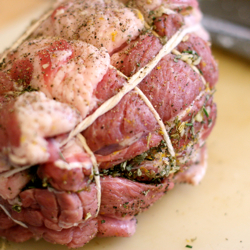 Even otherwise reasonable people have been known to complain about the length of the recipes in Judy Rogers’ Zuni Cafe Cookbook. Indeed, our favorite recipe for mock porchetta (which, unless you live in the Italian countryside or know someone who butchers their own hogs, is as close as you’re likely to get to the real thing) does run to many pages. But it’s anything but complicated — especially if you’re handy with a boning knife — and it’s not even all that time consuming. Once you’ve made the recipe a couple of times, you can have the roast prepped and stuffed in less than 20 minutes; once that work is done, you’re pretty much home free.
Even otherwise reasonable people have been known to complain about the length of the recipes in Judy Rogers’ Zuni Cafe Cookbook. Indeed, our favorite recipe for mock porchetta (which, unless you live in the Italian countryside or know someone who butchers their own hogs, is as close as you’re likely to get to the real thing) does run to many pages. But it’s anything but complicated — especially if you’re handy with a boning knife — and it’s not even all that time consuming. Once you’ve made the recipe a couple of times, you can have the roast prepped and stuffed in less than 20 minutes; once that work is done, you’re pretty much home free.
As our very patient friends will attest, the Zuni porchetta is a dish we love so much we can’t help hauling it out for dinner parties all the freakin’ time. The glistening, heavenly scented, herb-infused pork shoulder is a stunner, its vermouth-spiked pan sauce an exercise in decadence. And, oh harried host or hostess, you can even roast your side dishes right in the same pan as the porchetta — who doesn’t like rosemary-and-pork-drippings on their fennel and potatoes? (And what is their problem?)
But the dirty little secret, the real reason why we’ll use any flimsy excuse to trot out this old favorite, is that it makes the world’s best leftovers, hands down. Thinly sliced cold porchetta is brilliant on rustic bread with a schmear of ricotta and a few grinds of coarse black pepper. Larger bits, especially those doused in leftover gravy, make a stunning filling in a hollowed-out crusty roll. A handful of moist shreds add panache to a composed salad. The possibilities are, as they say, almost endless.
Despite all these lunchy luxuries, my favorite post-porchetta meal has got to be breakfast. Once you’ve had porchetta hash — especially when served with a perfectly poached pastured egg atop it and maybe some tomato-bourbon jam on the side — you may well forget about the corned-beef sort. Like the gorgeous love-child of crispy carnitas and silky rillettes, slow-cooked porchetta hash forms a golden-brown shell that hides a meltingly soft interior.
But first, you’ve got to make the porchetta.
I beg you: Don’t be daunted by the length of the recipe. Rogers has a knack for the subtle differences between a perfect outcome and a mediocre effort, and an all-too-rare talent for translating her technique into print. It’s nearly impossible for a pro to remember all the things she does by rote, the details that we amateurs need to be told explicitly, but Rogers gets this in spades.
Such a perfect recipe needs but one minor modification: Rodgers asks you to add the vegetables to pan, surrounding the roast, right at the start. I find they’re perfectly done if you add them at the one-hour mark, when you first turn the roast. (If you put your tongs on top of the veggie bowl, you won’t forget to add them.)
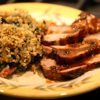
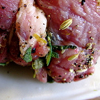


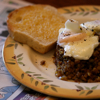
Mock Porchetta
— from The Zuni Cafe Cookbook
2-1/2 to 3-pound pork shoulder butt roast [Anita’s note: not the ‘picnic’ portion]
salt
1T capers, rinsed, pressed dry between towels, and barely chopped
1T lemon zest
3 garlic cloves, coarsely chopped
12 fresh sage leaves, crushed then coarsely chopped
a leafy sprig or two of fresh rosemary, leaves stripped and crushed (about 2T, packed)
2 tsp fennel seeds, barely crushed
1-1/2 tsp freshly cracked (not ground) black pepper
1 to 2 pounds prepared vegetables of your choice:
– carrot chunks, onion wedges, quartered fennel bulbs, baby potatoes, etc
a little mild-tasting olive oil
2/3 cup rich chicken stock
a few tablespoons of dry vermouth
Trimming, seasoning, and tying up the pork (1 to 3 days in advance):
Trim any discoloration and all but a 1/4-inch-thick layer of superficial fat from the pork. Study the natural seams between the muscles on each side of the meat. Choose one that runs the length of the roast and close to the center of any face. Use the tip of a knife to gingerly separate the muscles along that seam, gradually exposing more seams, which you should then separate as well. The goal is to create lots of internal surfaces to cake with seasonings. If your initial foray doesn’t expose many internal seams, you can take a second stab at a different face, so long as you don’t cut the pork in two. Salt the splayed piece of pork evenly all over (approximately 1/2 tsp of sea salt per pound of meat).
Combine the capers, lemon zest, garlic, sage, rosemary, with most of the fennel seeds and black pepper. (You should get about 1/2 cup, loosely packed.) Spread and pack this mixture all over the excavated insides of the pork butt, making sure the seasoning falls deep into the crannies where you’ve separated the muscles. Re-form the pork butt into its natural shape and tie tightly into a uniform shape, tying 4 or 5 strings around the circumference and another around the length of the roast. Rub the remaining fennel and pepper on the outside of the roast. Collect and refrigerate any loose herbs and seasonings. Cover the pork loosely and refrigerate.
Roasting the porchetta (2 1/4 to 2 1/2 hours)
Preheat the oven to 350°F. Toss the vegetables in a minimum of olive oil, barely coating the surfaces. Add a few pinches of salt and toss again; set aside.
Heat a 12- or 14-inch ovenproof skillet, depending on how many vegetables you are roasting, over medium heat. Place the pork roast in the pan; it should sizzle. Place in the oven.
The roast should begin to color at 45 minutes; if not, turn the heat up to 375°F until it does, then turn the heat back down.
At 1 hour, turn the roast over and add the vegetables, rolling them in the rendered fat. Work quickly, so you don’t lose too much oven heat and the roast doesn’t cool off. Turn the roast again at 2 hours and add about 1/3 cup of the stock or water.
Add any excess herbs and seasonings to the pan juices at this point and swirl the pan so they sink into the liquid. Roast for another 15 to 30 minutes, to about 185°F. The pork should be fragrant and glistening golden caramel.
Transfer the meat to a platter, tent loosely with foil, and leave in a warm, protected spot while you make the pan sauce. Place the vegetables on a separate warm plate.
Preparing the pan sauce and serving the roast
Tilt the skillet and spoon off the fat. Add the vermouth and the remaining 1/3 cup stock or water and set over low heat. Scrape and stir to dissolve the caramelized drippings on the bottom and sides of the pan. Skim the fat as the liquid comes to a simmer. Add any juice that may have trickled from the resting roast.
Slice the pork, removing the strings as you go, and serve garnished with the vegetables and a spoonful of the rich pan sauce.
cookbooks, meat, recipes
17 Comments »




Posted by Anita on 12.20.07 12:07 PM
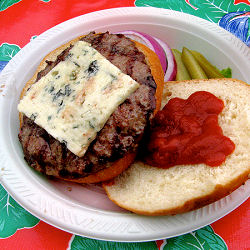 You remember last week’s mad locavore dinner streak? This week: Not so much. OK, sure, we managed to hit our baseline — two dinners made from 90% local ingredients over the course of a week. But with the holidays and crazy work deadlines looming, there simply wasn’t time to show off.
You remember last week’s mad locavore dinner streak? This week: Not so much. OK, sure, we managed to hit our baseline — two dinners made from 90% local ingredients over the course of a week. But with the holidays and crazy work deadlines looming, there simply wasn’t time to show off.
Still, we ate pretty well. Our first Dark Days Challenge meal of the week revolved around a fabulous batch of carnitas tacos — Range Brothers pork tucked inside Rancho Gordo tortillas — with Happy Quail poblano chile rajas, Primavera salsa, and a side of Rancho Gordo heirloom beans. Our usual Friday night pasta-fest — Eduardo’s linguine and our homemade sauce — featured a shaved fennel and apple salad made from homegrown fennel, Apple Farm apples, Point Reyes Blue cheese, and Bariani olive oil. As quick weeknight meals go, they weren’t too shabby… even if we only managed two dinners from within our foodshed this week.
But, as I keep having to reminding myself, there are 14 other meals every week.
Pretty much every breakfast we eat meets our challenge criteria. Our eggs and butter are Clover Organic, the bread comes from Acme, the preserves are usually gifts from friends (who use local fruit) or bought from June Taylor. On the weekends, our Saturday market ritual involves a stop at Primavera, where the menu proudly displays the names of the farmers who grow their delectable ingredients. And on Sundays, we fancy up our weekday fare with Fatted Calf or Range Bros. bacon, or homemade breakfast sausage.
Lunch, though, is a mixed bag. When leftovers aren’t an option, things can be pretty grim. The area around my office is mercifully light on mega-chain fast food and rich in gourmet-ish choices, but none of them are particularly locavore-friendly. There’s a branch of Out the Door, the quick-service sibling of San Francisco’s famed Slanted Door restaurant, but the best they can do is “organic whenever possible”.
 Twice a week, my options improve significantly.
Twice a week, my options improve significantly.
On Tuesdays, I hop the streetcar down to the Ferry Building for the lunchtime farmers market. During the market, Prather Ranch sells hamburgers on Acme buns, and Donna’s sells tamales and “enchamales”, locally made with some local ingredients.
There’s an array of not-quite-there options inside the Ferry Building itself, mostly local but non-organic, or vice-versa. If you’re feeling particularly wealthy, I suppose you could lunch on Tomales Bay oysters and Bay Area microbrews at the Hog Island bar overlooking the bay, but that’s a wee bit rich for my everyday budget.
On Wednesday, I head to the decidedly un-chic Heart of the City farmers market at Civic Center. I pick up a few midweek provisions, but my real goal is a quarter of a spit-roasted Fulton Valley chicken and a side of basted potatoes from Roli Roti. All things considered, it’s probably my favorite locavore lunch option, and relatively cheap by comparison.
All in all, my best bet for Dark Days lunches is planned leftovers. But, given how unsuccessful we’ve been this last week at actually putting food on our table, it’s a good thing that other options exist.

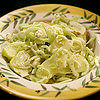

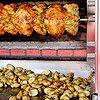
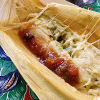
locavore, lunch
1 Comment »




Posted by Anita on 02.18.07 1:59 PM
 Happy Lunar New Year to all! We wish you prosperity and good luck for the coming year.
Happy Lunar New Year to all! We wish you prosperity and good luck for the coming year.
Today’s the first day of 4705, so what better way to celebrate the Year of the Fire Pig than with some our our favorite porky recipes…
..from the MwD archives:
New Year’s Cassoulet
Pear and Arugula Salad with Guanciale
Not-Spam and Eggs
Carnitas Tacos
Cochinita Pibil
..from swine-lovin’ friends and fellows:
Homemade sausage from Cookiecrumb at I’m Mad and I Eat
Milk-braised chops from Dr. Biggles at MeatHenge
Devils on Horseback from Sean at Hedonia
Tartiflette from Lucy’s Kitchen Notebook
Senate Bean Soup from Steve at Rancho Gordo
Larb from Molly at Orangette
Ants on a Tree from Matthew at Roots & Grubs
As soon as we start cooking and/or eating anything noteworthy again, I promise we’ll be back with some original content.
And stay tuned for another remodeling update, too. (I’ll be home on the 22nd, and Cameron says the kitchen is looking “so beautiful I want to sleep in it.”)
holidays & occasions, meat, other blogs, recipes
1 Comment »




Posted by Cameron on 12.23.06 4:53 PM
 San Francisco, hang your head in shame. Much as I love my City by the Bay, it’s never been a good place for pizza. The situation has improved in recent years, thanks to the likes of Pizzeria Delfina (If you can get in. if you want to pay $70 for pizza.), but only barely.
San Francisco, hang your head in shame. Much as I love my City by the Bay, it’s never been a good place for pizza. The situation has improved in recent years, thanks to the likes of Pizzeria Delfina (If you can get in. if you want to pay $70 for pizza.), but only barely.
I’ve always found the situation mystifying–but after today’s lunch it’s escalated to infuriating. Why, in the foodiest city in the country (hush you homers, I’m pontificating), is it practically impossible to get a decent pizza, when I can sit down to a magnificent Neapolitan pie at a strip mall in Henderson, Nevada?
Settebello has modern Vegas charm, which is to say that it’s cavernous, painfully clean, clangingly empty, and so new that you can practically smell the fresh concrete. The sheer size of even the smallest of these commercial spaces dwarfs any attempt at coziness, but Settebello manages to inject some warmth–perhaps it was the overwrought Italian pop music wafting through the sound system. Could have been the Real Madrid game on the widescreen TV. Perhaps it was the friendly staff. Might have been the giant mural of the Bay of Napoli on the wall, or the Italian travel posters. Could it have been the enormous pizza oven?!
The menu is simple, built around Neapolitan pizza. Settebello has been certified by Vera Pizza Napoletana, a distinction that it shares with Seattle’s Via Tribunali, among others. We’ll pass lightly over the absurdity of creating a committee to preserve taste, but only because the pizza at Settobello is very, very, good. I defiled the purity of my margherita with finocchiona from Salumi, secure in the knowledge that “Variations of pizzas are recognized if they are informed by the Neapolitan tradition of pizzas and are not in contrast with the rules of gastronomy.” The pie and its precious cargo were worthy of each other’s company. The sauce and cheese were light, fresh, and applied with a gentle hand. The crust wasn’t quite as perfect, but according to the folks at Valley Wine and Cheese across the parking lot, there have been some oven issues that needed sorting out. Anita’s calzone wasn’t as spectacular as my “margherita con…”, but was still very good.
Nitpicking. Pure nitpicking. This is seriously good pizza. I can’t wait to try the bianca. It will be a sad trip to Henderson that doesn’t include a visit to Settebello, and a sad flight back to pizza wasteland that is San Francisco. I shall console myself with carnitas and birria.
Settebello Pizzeria Napoletana
1776 W. Horizon Ridge Parkway
Henderson, NV 89052
702.222.3556
Italian, restaurants, Vegas
6 Comments »




Posted by Anita on 09.13.06 8:13 AM
 Over at The Traveler’s Lunchbox, Melissa posed a challenge to her fellow food-bloggers: List the five things everyone should eat before they die.
Over at The Traveler’s Lunchbox, Melissa posed a challenge to her fellow food-bloggers: List the five things everyone should eat before they die.
Erin tagged us to participate back at the end of August, and we’ve been bickering about it ever since. Does it mean five natural foodstuffs? Five prepared dishes? Five culinary experiences? Five meals? Being a rather ecumenical gal, I’m inclined to interpret the question in the broadest terms; Cameron’s being a little more dogmatic, and — hey, no value judgement here — is not surprisingly having a very hard time coming up with his answers. I, on the other hand, am having a terrible time limiting myself to just five. Argh.
But, after a couple weeks of pensive nail-biting, I think I can safely say that you, my foodie friends, should go forth and eat the following five items. But don’t go dying on me any time soon, ok?
1. street food in Thailand, preferably breakfast at the Damnoen Saduak floating market. I recommend kanom krok, soup noodles, thai coffee, and a mango, but feel free to sample whatever’s being made by the ladies with woks in their wooden boats. We spent 3 weeks in central and northern Thailand this past January, eating street food every day. And while we did have some nice meals in restaurants, it’s the noodle-shop nosh and street-stall snacks that still haunt me.
2. heritage pork in Britain. Your choice: a pork & stilton sandwich at Borough Market, or roast middlewhite at St. John. Or both, hey… don’t let me stop you. Even the best pig I’ve eaten stateside is a pale, pasty shadow of the succulent swine they’ve got over in Blighty. Despite the weakness of the dollar and the superstrength of the pound, it’s a taste-memory that’s worth the cost of airfare.
3. tacos from a taco truck, preferably carnitas at the El Asadero taco bus on South Rainier in Seattle. This was the year I got over my fear of street food. I shudder to think of all the amazing food I missed. I’m not particularly squeamish or germ-phobic, but I am a total wimp when it comes to busting out of my cultural comfort zone. For some reason, having mastered the the taco truck experience over the last couple of years made it easier to go outside the boundaries and let 2006 become the Year of Eating Dangerously for this former fussy eater. So far this year, I’ve eaten sushi at 6am in Tokyo (prepared by chefs with whom I shared absolutely no common language), all kinds of crazy nutty wacky stuff in Thailand, escamole in Mexico, and a host of other oddities… and the year’s not yet over.
4. a meal made entirely from peak-season farmer’s market finds. Although I’ve always been dedicated to the idea of seasonal and farm-direct cooking, this summer was the first time we could honestly say that 100% of the ingredients for certain meals — including staples like oils and salts — came from the market. The cynical me is surprised that it really makes such a difference, but the nutty-crunchy side of me realizes this is one of them-there culinary no-brainers.
5. the tasting menu at The French Laundry. A quick glance at other blogger’s contributions to this meme shows I’m not alone on this one. But really… it’s one of the few high-end dining experiences that’s objectively worth every penny that you pay for it. This meal will genuinely change the way you think about dining out and — if you’re particularly introspective — about cooking as well. My photos certainly don’t do it justice, nor do any of the (admittedly plentiful and generally well-written) first-hand accounts you’ve read online. Clear your morning schedule, put the phone on speed-dial, and pray for an opening: I promise you won’t regret it.
————–
Oh, I almost forgot to pick the next five other bloggers — which is getting really hard, as it seems like nearly everyone‘s already taken a crack. So, tag… you’re it!
- Sean at Hedonia
- Lucy at Lucy’s Kitchen Notebook
- Cheryl at Cupcake Bakeshop by Chockylit
- Matthew at Roots & Grubs
- Mary at Jalapeño Girl
breakfast, cooking, farmers markets, meat, Mexican, other blogs, restaurants, Thai, travel
6 Comments »




 Despite our enduring love for our nieces and pint-sized friends, this blog will never feature the sort of recipes that usually pass for kid-friendly meals. With high-octane cocktails, labor-intensive recipes, and frequent bouts of profanity, no sane reader would ever mistake me for a mommy blogger. And yet, one of the best food books I’ve read in quite some time — one I actually forked over cash to buy — is Hungry Monkey: A Food-Loving Father’s Quest to Raise an Adventurous Eater. A title that’s shelved not with the cookbooks, but in the heretofore unexplored Baby & Toddler section of my local bookstore.
Despite our enduring love for our nieces and pint-sized friends, this blog will never feature the sort of recipes that usually pass for kid-friendly meals. With high-octane cocktails, labor-intensive recipes, and frequent bouts of profanity, no sane reader would ever mistake me for a mommy blogger. And yet, one of the best food books I’ve read in quite some time — one I actually forked over cash to buy — is Hungry Monkey: A Food-Loving Father’s Quest to Raise an Adventurous Eater. A title that’s shelved not with the cookbooks, but in the heretofore unexplored Baby & Toddler section of my local bookstore.


















































 Happy
Happy  San Francisco, hang your head in shame. Much as I love my City by the Bay, it’s never been a good place for pizza. The situation has improved in recent years, thanks to the likes of Pizzeria Delfina (If you can get in. if you want to pay $70 for pizza.), but only barely.
San Francisco, hang your head in shame. Much as I love my City by the Bay, it’s never been a good place for pizza. The situation has improved in recent years, thanks to the likes of Pizzeria Delfina (If you can get in. if you want to pay $70 for pizza.), but only barely. Over at
Over at